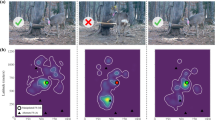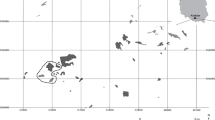Abstract
Understanding responses of organisms to spatial heterogeneity in resources has emerged as a fundamentally important challenge in contemporary ecology. We examined responses of foraging herbivores to multi-scale heterogeneity in plants. We asked the question, “Is the behavior observed at coarse scales in a patch hierarchy the collective outcome of fine scale behaviors or, alternatively, does the spatial context at coarse scales entrain fine scale behavior?” To address this question we created a nested, two-level patch hierarchy. We examined the effects of the spatial context surrounding a patch on the amount of time herbivores resided in the patch. We developed a set of competing models predicting residence time as a function of the mass of plants contained in a patch and the distance between patches and examined the strength of evidence in our observations for these models. Models that included patch mass and inter-patch distance as independent variables successfully predicted observed residence times (bears: r 2=0.67–0.76 and mule deer: r 2=0.33–0.55). Residence times of grizzly bears (Ursus arctos) and mule deer (Odocoileus hemionus) responded to the spatial context surrounding a patch. Evidence ratios of Akaike weights demonstrated that models containing effects of higher levels in the hierarchy on residence time at lower levels received up to 34 times more support in the data than models that failed to consider the higher level context for grizzly bears and up to 48 times more support for mule deer. We conclude that foraging by large herbivores is influenced by more than one level of heterogeneity in patch hierarchies and that simple empirical models offer a viable alternative to optimal foraging models for the prediction of patch residence times.



Similar content being viewed by others
References
Åstrom M, Lundberg P, Danell K (1990) Partial prey consumption by browsers—trees as patches. J Anim Ecol 59:287–300
Bailey DW, Gross JE, Laca EA, Rittenhouse LR, Coughenour MB, Swift DM, Sims PL (1996) Mechanisms that result in large herbivore grazing distribution patterns. J Range Manag 49:386–400
Burnham KP, Anderson DR (2002) Model selection and multimodel inference: a practical information—theoretic approach, 2nd edn. Springer, Berlin Heidelberg New York
Cassini MH, Lichtenstein G, Ongay JP, Kacelnik A (1993) Foraging behavior in Guinea-pigs—further tests of the marginal value theorem. Behav Process 29:99–112
Charnov EL (1976) Optimal foraging, the marginal value theorem. Theor Popul Biol 9:129–136
Danell K, Edenius L, Lundberg P (1991) Herbivory and tree stand composition—moose patch use in winter. Ecology 72:1350–1357
Distel RA, Laca EA, Griggs TC, Demment MW (1995) Patch selection by cattle: maximization of intake rate in horizontally heterogeneous pastures. Appl Anim Behav Sci 45:11–21
Dumont B, Carrere P, D’Hour P (2002) Foraging in patchy grasslands: diet selection by sheep and cattle is affected by the abundance and spatial distribution of preferred species. Anim Res 51:367–381
Edenius L, Ericsson G, Naslund P (2002) Selectivity by moose vs the spatial distribution of aspen: a natural experiment. Ecography 25:289–294
Edwards GR, Newman JA, Parsons AJ, Krebs JR (1994) Effects of the scale and spatial distribution of the food resource and animal state on diet selection: an example with sheep. J Anim Ecol 63:816–826
Fierer N, Kotler BP (2000) Evidence for micropatch partitioning and effects of boundaries on patch use in two species of gerbils. Funct Ecol 14:176–182
Fortin D, Fryxell JM, Pilote R (2002) The temporal scale of foraging decisions in bison. Ecology 83:970–982
Goddard J (1968) Food preferences of two black rhinoceros populations. East Afr Wildl J 6:1–18
Hobbs NT, Hilborn R (2005) Alternatives to statistical hypothesis testing in ecology. Ecol Appl (in press)
Illius AW, Duncan P, Richard C, Mesochina P (2002) Mechanisms of functional response and resource exploitation in browsing roe deer. J Anim Ecol 71:723–734
Jiang Z, Hudson RJ (1993) Optimal grazing of wapiti cervus-elaphus on grassland patch and feeding station departure rules. Evol Ecol 7:488–498
Johnson CJ, Parker KL, Heard DC (2001) Foraging across a variable landscape: behavioral decisions made by woodland caribou at multiple spatial scales. Oecologia 127:590–602
Kolasa J, Pickett STA (1991) Ecological heterogeneity. Springer, Berlin Heidelberg New York
Kotler BP, Gross JE, Mitchell WA (1994) Applying patch use to assess aspects of foraging behavior in Nubian ibex. J Wildl Manag 58:299–307
Kotliar NB, Wiens JA (1990) Multiple scales of patchiness and patch structure—a hierarchical framework for the study of heterogeneity. Oikos 59:253–260
Laca E, Ortega IM (1995) Integrating foraging mechanisms across spatial and temporal scales. In: West NE (ed) Rangelands in a sustainable biosphere. Society for Range Management, Denver, pp 129–132
Laca EA, Distel RA, Griggs TC, Deo GP, Demment MW (1993) Field test of optimal foraging with cattle: the marginal value theorem successfully predicts patch selection and utilisation. In: Proceedings of XVII international grassland congress, New Zealand and Queensland, February 1993, pp 709–701
Laca EA, Ungar ED, Demment MW (1994) Mechanisms of handling time and intake rate of a large mammalian grazer. Appl Anim Behav Sci 39:3–19
McNaughton SJ (1989) Interactions of plants of the field layer with large herbivores. Symp Zool Soc Lond 61:15–29
Moen R, Pastor J, Cohen Y (1997) A spatially explicit model of moose foraging and energetics. Ecology 78:505–521
Moen R, Cohen Y, Pastor J (1998) Linking moose population and plant growth models with a moose energetics model. Ecosystems 1:52–63
Parker KL, Gillingham MP, Hanley TA, Robbins CT (1996) Foraging efficiency: energy expenditure versus energy gain in free-ranging black-tailed deer. Can J Zool Rev Can Zool 74:442–450
Ritchie ME (1998) Scale-dependent foraging and patch choice in fractal environments. Evol Ecol 12:309–330
Schaefer JA, Messier F (1995) Winter foraging by muskoxen: a hierarchical approach to patch residence time and cratering behavior. Oecologia 104:39–44
Schmidt KA, Brown JR (1996) Patch assessment in fox squirrels: the role of resource density, patch size, and patch boundaries. Am Nat 147:360–380
Searle KR, Vandervelde T, Hobbs NT, Shipley LA (2005) Gain functions for large herbivores in small patches: tests of alternative models. J Anim Ecol 74:181–189
Senft RL, Coughenour MB, Bailey DW, Rittenhouse LR, Sala OE, Swift DM (1987) Large herbivore foraging and ecological hierarchies. Bioscience 37:789–799
Shipley LA, Spalinger DE (1995) Influence of size and density of browse patches on intake rates and foraging decisions of young moose and white-tailed deer. Oecologia 104:112–121
Sibbald AM, Hooper RJ (2003) Trade-offs between social behaviour and foraging by sheep in heterogeneous pastures. Behav Process 61:1–12
Spalinger DE, Hobbs NT (1992) Mechanisms of foraging in mammalian herbivores: new models of functional response. Am Nat 140:325–348
Spalinger DE, Hanley TA, Robbins CT (1988) Analysis of the functional response in foraging in the Sitka black-tailed deer. Ecology 69:1166–1175
Vivås HJ, Sæther BE (1987) Interactions between a generalist herbivore, the moose Alces alces, and its food resources: an experimental study of winter foraging behaviour in relation to browse availability. J Anim Ecol 56:509–520
WallisDeVries MF, Laca EA, Demment MW (1999) The importance of scale of patchiness for selectivity in grazing herbivores. Oecologia 121:355–363
Ward D, Saltz D (1994) Foraging at different spatial scales: Dorcas gazelles foraging for lilies in the Negev Desert. Ecology 75:48–58
Wilmshurst JF, Fryxell JM, Farm BP, Sinclair ARE, Henschel CP (1999) Spatial distribution of Serengeti wildebeest in relation to resources. Can J Zool Rev Can Zool 77:1223–1232
Zollner PA, Lima SL (1999) Search strategies for landscape-level interpatch movements. Ecology 80:1019–1030
Acknowledgements
This work was funded by National Science Foundation grants to Hobbs and Wunder (DEB 9981368) and to Shipley (DEB 9981242). We are grateful to the staff of the Colorado Division of Wildlife Foothills Research Facility at Fort Collins, CO, for help with the mule deer trials. We thank S. Albers, K. Bikowski, C. Bishop, S. Hobbs, W. Mulherin, L. Reynolds, and M. Rice for their invaluable assistance in animal care and field trials in Fort Collins. We appreciate the generosity of C.T. Robbins for allowing us to use the grizzly bears and facilities at the Bear Conservation and Research Center at Washington State University in Pullman, WA. T. Tollefson and M. Fisher helped conduct experiments with grizzly bears. We also thank Dr. M. McClure, Dr. B. Kotler, Dr. E.A. Laca and Dr. M. Åström for excellent reviews of this manuscript.
Author information
Authors and Affiliations
Corresponding author
Additional information
Communicated by Craig Osenberg
Rights and permissions
About this article
Cite this article
Searle, K.R., Vandervelde, T., Hobbs, N.T. et al. Spatial context influences patch residence time in foraging hierarchies. Oecologia 148, 710–719 (2006). https://doi.org/10.1007/s00442-005-0285-z
Received:
Accepted:
Published:
Issue Date:
DOI: https://doi.org/10.1007/s00442-005-0285-z




